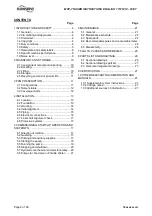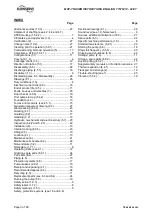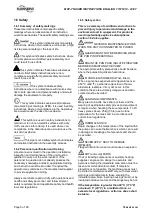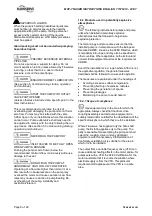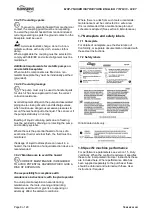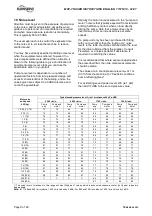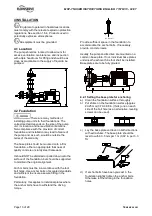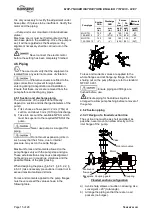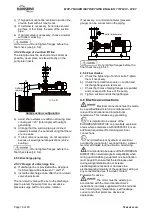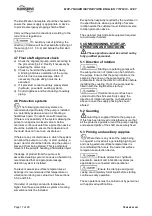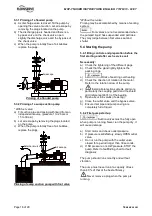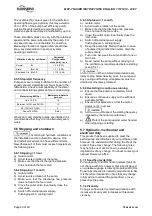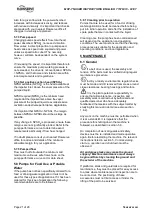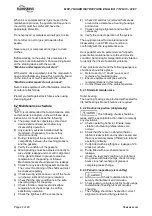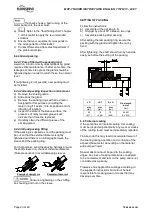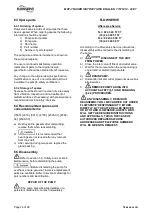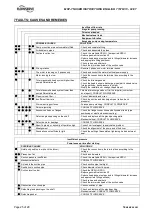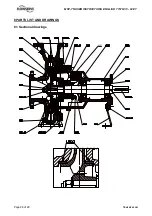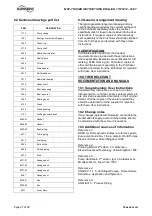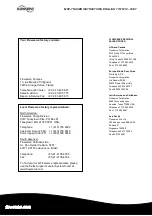
MHP-TN USER INSTRUCTIONS ENGLISH 71576313 - 02/07
Page 16 of 28
flowserve.com
c)
If high points cannot be avoided in suction line,
provide them with air relief cocks.
d)
If a strainer is necessary, its net area should
be three or four times the area of the suction
pipe.
e) If an inlet valve is necessary, choose a model
with direct crossing.
Do not tighten flanges before the
final check (see § 4.5.4).
4.5.2.2 Design of a suction lift line
The inlet pipe must be as short and as direct as
possible, never place an elbow directly on the
pump inlet nozzle.
I
Sufficient
immersion
D
I
3 x D
Sump suction configuration
a) Avoid sharp elbows or sudden narrowing. Use
convergent
20° (total angle) with upright
generating.
b)
Arrange that the suction piping is inclined
upwards towards the pump ensuring that there
are no peaks.
c)
If a foot valve is necessary, do not oversize it
because it would generate pulsations (valve
beating).
Do not tighten flanges before the
final check (see § 4.5.4).
4.5.3 Discharge piping
4.5.3.1 Design of a discharge line
a) If discharge line is provided with a divergent,
its total angle will be between 7° and 12°.
b)
Install the discharge valve after the non-return
valve downstream.
The non-return valve will be set in the discharge
pipe to protect the pump from any excessive
pressure surge and from reverse rotation.
If necessary, a control manometer (pressure
gauge) can be connected on the piping.
Control manometer
Do not tighten flanges before the
final check (see § 4.5.4).
4.5.4 Final checks
a)
Check the tightening of anchor bolts. Tighten
them if necessary.
b)
Check that protective covers on suction and
discharge flanges are removed.
c)
Check that holes of piping flanges are parallel
and correspond to those of the pump.
d)
Tighten suction and discharge flanges.
4.6 Electrical connections
Electrical connections must be made
by a qualified Electrician in accordance with
relevant local national and international
regulations. This includes any grounding.
It is important to be aware of the
EUROPEAN DIRECTIVE on potentially explosive
areas where compliance with IEC60079-14 is an
additional requirement for making electrical
connections.
Avoid mechanical, hydraulic or electrical
overload by using motor overload trips or a power
monitor and make routine vibration monitoring.
It is important to be aware of the EUROPEAN
DIRECTIVE on electromagnetic compatibility when
wiring up and installing equipment on site. Attention
must be paid to ensure that the techniques used
during wiring/installation do not increase
electromagnetic emissions or decrease the
electromagnetic immunity of the equipment, wiring or
any connected devices. If in doubt, contact
Flowserve for advice.
The motor must be wired up in
accordance with the motor manufacturer's
instructions (normally supplied within the terminal
box) including any temperature, earth leakage,
current and other protective devices as
appropriate.

